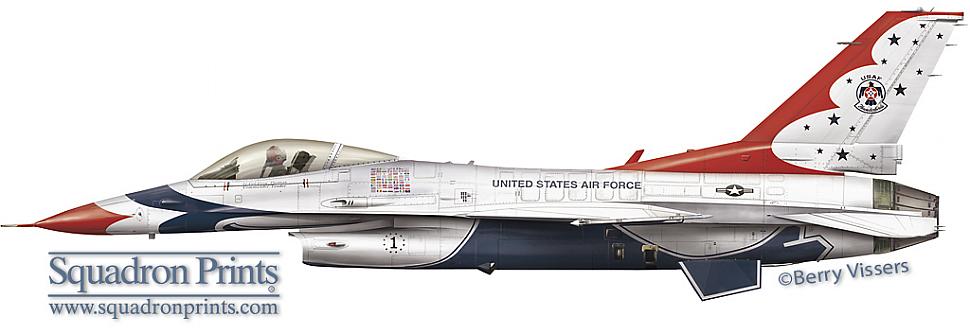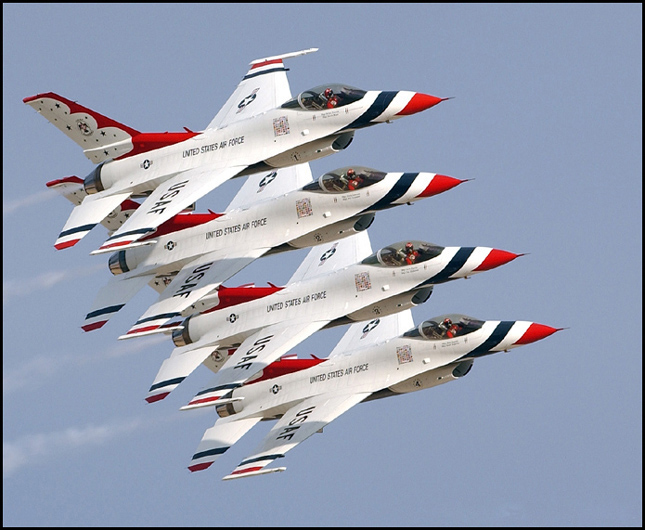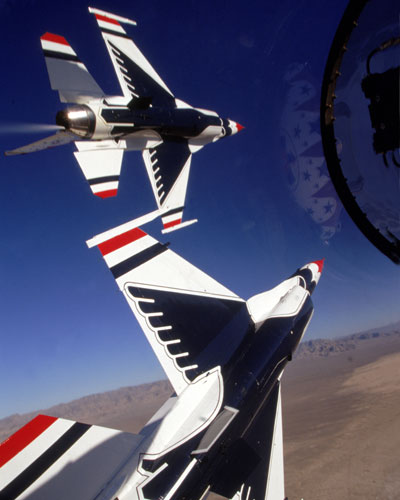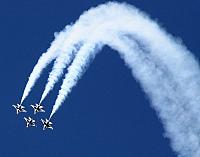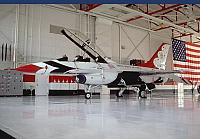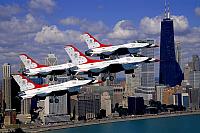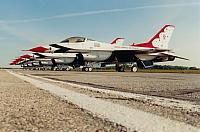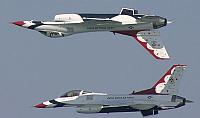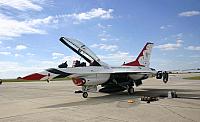 |
USAF - Air Demonstration Squadron ( USAF ACC)" Thunderbirds" |
 |
Air Demonstration Squadron " Thunderbirds" ( USAF ACC) | |||
| Status: |
Active
|
|||
| Version: | F-16C/D block 52 | |||
| Role: | Demonstrations | |||
| Tailband: | N/A | |||
| Motto: | N/A | |||
| Badge: | A stylised eagle with an American star in the center and 'Thunderbirds' marking below. | |||
F-16 History
Inception of the Air Demonstration Squadron (ADS) was on June 1st, 1953 at Luke AFB, Arizona. At the time, the unit had not been named and was officially known as the 3600th Air Demonstration Squadron. Having no name, a contest was held at Luke AFB in June of 1953 to select a name. As is still used today, the name chosen was Thunderbirds.
The first team was handpicked from Luke AFB only and flew the F-84G. The first show took place only a week after the inception date of the squadron on June 8th, 1953 at its home base Luke before a small crowd. Even before the squadron was officially recognized, they had been practicing for weeks. The Thunderbirds first major show took place over the days of September 5-7th, 1953 at the Dayton air show in Ohio.
For the 1955 season, the Thunderbirds converted to the F-84F 'Thunderstreak' which was a swept wing version of the F-84G. Following the 'Thunderstreak' was the F-100C which was a supersonic aircraft. During the F-100 conversion also brought a new home base. The Thunderbirds moved to their current home at Nellis AFB, Nevada. In 1958 the Thunderbirds where awarded the Air Force Outstanding Unit Award
In 1963 the Thunderbirds converted to the F-105B 'Thunderchief' for a short while only as an accident grounded the team. To save the season the team quickly converted back to the F-100 'Super Sabre' but this time flew the D model.
The 1969 season saw the first of Thunderbirds with the F-4E. The F-4E was a powerful aircraft and a crowd pleaser. The F-4E was dropped due to the energy crisis in the early 70's. In its place, the T-38A was chosen which was smaller and not as noisy, but did use far less fuel and required less maintenance. The infamous "Diamond Crash" happened with the T-38 during a practice flight on January 18th, 1982 in which the entire team flew into the range. The four aircraft involved where 68-8156, 68-8175, 68-8176 and 68-8184. As a result of this tragic loss, no shows were flown by the Thunderbirds during the 1982 season. Instead the unit took the time to convert to a new aircraft type.
As a replacement for the T-38A the Thunderbirds were given the F-16A/B block 15. The F-16 had been considered as a replacement long before the diamond crash. The first Thunderbird painted F-16 arrived at Nellis AFB, Nevada on June 22nd, 1982. After 18 months with no show due to the "Diamond Crash" the first show returning to the air and with a new aircraft was on April 2nd, 1983.
In a rather special performance the team flew to Luke AFB, Arizona on October 5th, 1989 to fly a private demonstration specifically for the Soviet Union Defense Minister, General Dimitry Yazov.
After the 1991 season and a European tour, the Thunderbirds converted from the F-16A/B to the F-16C/D block 32.
As part of the opening ceremonies for the 1996 Olympic Games held in Atlanta, the Thunderbirds performed a flyby at the end of the American national anthem. The team performed the 1000th demonstration in the F-16 at Pope AFB, North Carolina on November 10th, 1996. The following year in 1997 to celebrate the USAF's 50th anniversary. The US Postal Service used the Thunderbirds to represent the USAF for a commemorative stamp. That year the unit wore a special marking just behind the cockpit indicating the USAF's 50th anniversary. In 2003 the USAF Thunderbirds celebrated their 50th anniversary although no special markings were applied.
Although not assigned, the USAF Thunderbirds do obtain for their own use cargo aircraft from other squadrons. Their first support aircraft was the C-123B 'Provider' followed by the C-119F in 1958. In preparation for Desert Storm the USAF Thunderbirds season was shortened and gave up their C-141B 'Starlifters' for C-130s. After the war the C-141B returned for a short while as half way through the 1993 season all C-141s were grounded and the Demonstration team used two C-130s. After the retirement of the C-141 it has been difficult as operating two C-130s has been expensive and C-17 numbers were too small. Since around 2006 the C-17 has been primarily used and just like in the past none are dedicated to the team. Which ever one is available as a spare and is given the call sign of Thunderbird fourteen.
Converting an F-16 into a Thunderbird aircraft is rather simple task. The radar is removed as well as the gun. In place of the gun is equipment and holding tanks for the smoke generators. A pipe is run from the gun bay to the afterburner where oil is burned in the engine to make smoke. Finally the F-16 is painted in the trademark paint scheme. The ADS team claims to be able convert an F-16 back to operational status within a 72 hour period. This was tried in 1988 with F-16 #81-0679 and done in only 27 hours except for painting the aircraft.
In 2005 the Thunderbirds made history when it was announced that Thunderbirds had selected their first female pilot. Captain Nicole Malachowski had a major work load ahead of her when she accepted the assignment as she had no experience in the F-16 coming from the F-15 world. Captain Malachowski was quickly sent to Luke AFB, Arizona to qualify in the F-16. After qualifying in the F-16 she showed up for duty to take up position as Thunderbird number three which is on the right wing of the diamond formation. She eased into the position without much trouble and was welcomed by the public in 2006 season.
Marking the 60th Anniversary of the USAF, each Thunderbird F-16 had a special decal added to the left side of the aircraft below the canopy for the 2007 season. Another addition was another female pilot, Major Samantha Weeks, who took up the position of opposing solo, Thunderbird number six while Captain Malachowski remained number three.
The USAF has no plans to change aircraft and this is unlikely to change for a number of years. A clear replacement for the F-16 would be the F-35, but it is likely that the F-16 will be the longest aircraft operated by the Thunderbirds. In 2008 the block 32 F-16s were replaced by newer block 52 models. This gives the team an extra boost in available thrust.
In a surprising move on March 1, 2013 the United States Air Force announced cancellation of the 2013 season. More widespread than the Thunderbird season, the move also effected the support for all air shows, tradeshows, flyovers (including funerals and military graduations), orientation flights, heritage flights, F-22 demonstration flights and open houses, unless the event included only local static displays. The USAF Thunderbird crews will complete their certification procedures for safely flying aerial demonstrations in case the budget allows resumption of scheduled events in 2013. The squadron will stand down as of April 1, 2013 with plans to reevaluate for the next year. Prior to the deadline of April 1, the squadron flew a few fly-by's and a couple shows with the last scheduled for Mar 23 and 24 at Titusville, Florida. The Thunderbirds were looking forward to marking 60 years and a late in the season deployment to the Pacific/Asia tour.
Aircraft Markings History
The tail has a white background with golden stars, a red leading tail edge and the Thunderbirds logo in the center of the tail.
Unit History
- Activation of the squadron in Luke (as 3600 Air Demonstration Unit)
- 1953: F-84G 'Thunderjet'
- 1955: F-84F 'Thunderstreak'
- 1956: F-100C 'Super Sabre' (Nellis AFB, Nevada, part of 388 TFW)
- 1964: F-105B 'Thunderchief'
- 1964: F-100D 'Super Sabre'
- 1969: F-4E 'Phantom II'
- 1974: T-38A 'Talon'
- 1983: F-16A/B 'Fighting Falcon'
- 1992: F-16C/D 'Fighting Falcon'
Deployments
 |
' Europe, Hawaii and Latin America' |
| 1984 & 1985 | |
| First time to Norway, Hawaii was done to mark the 25th anniversary of joining the United States. Five countries in Latin America. | |
 |
' The Friendship Tour' |
| 1987 | |
| Visited Guam, China, Thailand, Malaysia, Singapore, Indonesia, Australia, Hawaii, Philippines, Republic of Korea and Japan. | |
 |
' Europe and South America' |
| 1991 | |
| Flew for Switzerland, Poland and Hungary for the first time. | |
 |
' Thunder Over the Pacific' |
| 1994 | |
| Flying in Japan, Korea, Thailand, Singapore and Malaysia. | |
 |
' Let Freedom Reign & Golden Air Tattoo' |
| 1996 and 1997 | |
| A month-long European tour. | |
 |
' Asian Tour' |
| 2004 & 2013? | |
| Flying in Korea, Guam and Japan. August and September of 2013 was announced with a possible cancellation of the 2013 season may result in this tour not happening. |
F-16 Airframe Inventory
- All Air Demonstration Squadron F-16s in our F-16 Aircraft Database (past and current aircraft)
- Current Air Demonstration Squadron F-16s in our F-16 Aircraft Database
Photos
Please use this form to add any list any error or omissions you find in the above text.
Note: your comments will be displayed immediately on this page. If you wish to send a private comment to the webmasters, please use the Contact Us link.

